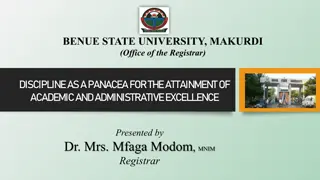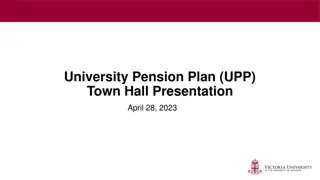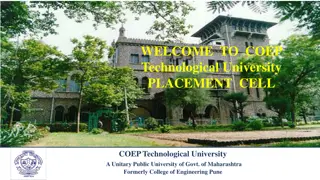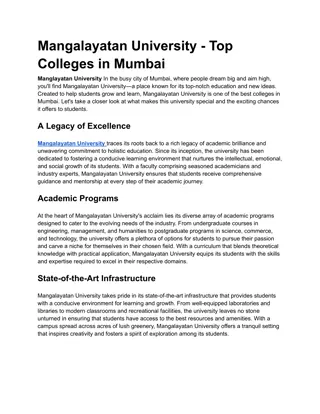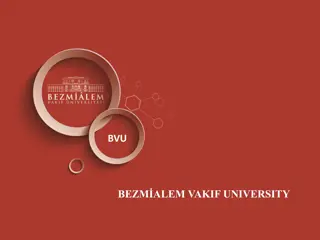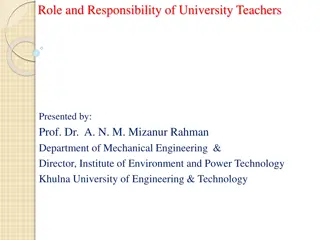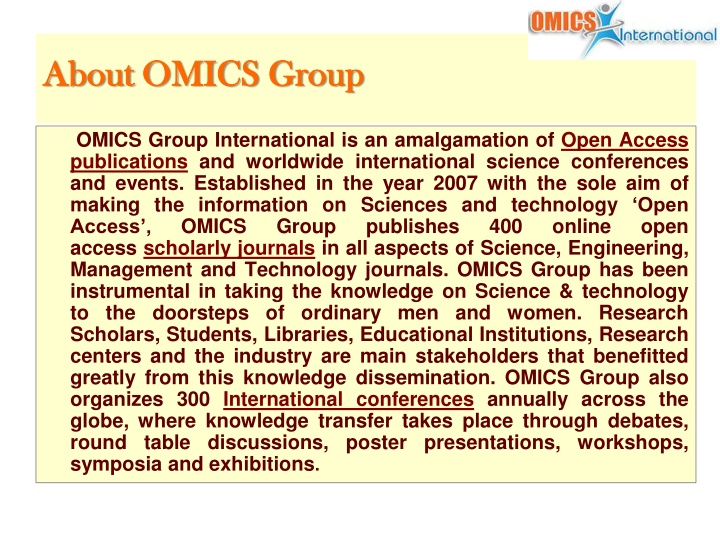
OMICS Group: Pioneering Open Access Journals and Science Conferences
OMICS Group International, established in 2007, is a prominent organization dedicated to disseminating information on Sciences and technology through open access publications and international science conferences. With a focus on Science, Engineering, Management, and Technology, OMICS Group benefits research scholars, students, libraries, educational institutions, and industries worldwide. The group organizes over 300 international conferences annually and publishes around 400 open access journals. This content highlights a study on the flexural, thermal, and erosive wear performance of PEI/TiO2 composites conducted at a conference in San Francisco.
Download Presentation

Please find below an Image/Link to download the presentation.
The content on the website is provided AS IS for your information and personal use only. It may not be sold, licensed, or shared on other websites without obtaining consent from the author. If you encounter any issues during the download, it is possible that the publisher has removed the file from their server.
You are allowed to download the files provided on this website for personal or commercial use, subject to the condition that they are used lawfully. All files are the property of their respective owners.
The content on the website is provided AS IS for your information and personal use only. It may not be sold, licensed, or shared on other websites without obtaining consent from the author.
E N D
Presentation Transcript
About OMICS Group About OMICS Group OMICS Group International is an amalgamation of Open Access publications and worldwide international science conferences and events. Established in the year 2007 with the sole aim of making the information on Sciences and technology Open Access , OMICS Group publishes access scholarly journals in all aspects of Science, Engineering, Management and Technology journals. OMICS Group has been instrumental in taking the knowledge on Science & technology to the doorsteps of ordinary men and women. Research Scholars, Students, Libraries, Educational Institutions, Research centers and the industry are main stakeholders that benefitted greatly from this knowledge dissemination. OMICS Group also organizes 300 International conferences annually across the globe, where knowledge transfer takes place through debates, round table discussions, poster presentations, workshops, symposia and exhibitions. 400 online open
About OMICS Group Conferences About OMICS Group Conferences OMICS Group International is a pioneer and leading science event organizer, which publishes around 400 open access journals and conducts over 300 Medical, Clinical, Engineering, Life Sciences, Pharma scientific conferences all over the globe annually with the support of more than 1000 scientific associations and 30,000 editorial board members and 3.5 million followers to its credit. OMICS Group has organized 500 conferences, workshops and national symposiums across the major cities including San Francisco, Las Vegas, San Antonio, Omaha, Orlando, Raleigh, Santa Clara, Chicago, Philadelphia, Baltimore, United Kingdom, Valencia, Dubai, Beijing, Hyderabad, Bengaluru and Mumbai.
GEDZ UNIVERSITY, ENGINEERING FACULTY,DEPARTMENT OF MECHANICAL ENGINEERING,TURKEY. 3st INTERNATIONAL CONFERENCE AND EXHIBITION ON MECHANICAL & AEROSPACE ENGINEERING INVESTIGATION OF THE EFFECT OF TIO2ON THE THERMAL,MECHANICAL AND EROSIVE PROPERTIES OF AVIATION THERMOPLASTIC COMPOSITES Fuat OKUMU fokumus1953@hotmail.com San Francisco,USA, October 05-07, 2015. 3
CONTENTS I. MAIN GOAL OF THE STUDY II. GENERAL III. MATERIAL AND METHOD IV. CONCLUSIONS. V.REFERENCES 4
I. MAIN GOAL OF THE STUDY In this study, we carried out the flexural, thermal, and erosive wear performance of PEI /TiO2composites. we tested PEI/TiO2composites containing varying amounts 5,10,15,20,25, and 30 % by weight (wt%) of a TiO2particle filler. We measured the erosive-wear resistance of these PEI /TiO2composites, and their flexural properties both before and after undergoing erosion. We also determined the thermal stability of the composites using thermogravimetric analysis methods. 5
II. GENERAL Polyetherimide (PEI) is a semicrystalline aromatic polymer which possesses excellent mechanical properties,good stability at eleveted temperature,outstanding chemical resistance,and inherent flame retardancy.In addition to these advantages,the relatively low material cost and good process ability make PEI a highly competative engineering material among current high-performance thermoplastics. 6
Generally, thermoplastc composites, particularly in automotive applications, high performance aircraft and aerospace structures have become increasingly popular on account of their many advantages, including good fracture toughness, increased impact resistance, higher solvent resistance, high specific stiffness and specific strength. 7
Moreover, thermoplastic composites possess the unique characteristic that they may be remelted and repaired; they can be remelted for repairing local cracks and delaminations. As a result of their potential for high production rates and lowmaterial costs, thermoplastic composites are of interest in a wide range of sectors including the automotive, construction and aerospace industries 8
* III.MATERIAL AND METHODE *In this study,we prepared the Polyetherimide(PEI) thermoplastic composite samples with different TiO2 particle concentrations using twin-screw extruder and injection molding machines.The Polyetherimide used as the matrix resin material for the composite and as the filler material used technical 99% grade titanium two oxide(commercial code 13551) . The size of the TiO2 particles was approximately 220nm. The proccessing parameters employed for the micro- compounder and for injection molding are given in the table 1. 9
Table 1.The processing parameters for the Polyetherimide thermoplastic composites Barrel temperature (0C) Compounding round (rpm) Compounding time (min.) Injection pressure (bar) Holding pressure (bar) Mold tempera ture (0C) Micro- Compounder 330 120 3 - - - Injection molding - - - 150 12 12 10
*The pure Polyetherimide (PEI) granules were dried in an electric oven at 80 C0for 24 h. before preparing the thermoplastic composites. *We then weighed the Polyetherimide granules and TiO2 particles in the requisite proportions and compounded them in the micro-compounder to obtain the different samples. *To test the erosive wear properties, the thermoplastic composite samples were eroded under 300and 900 impingement angles in an erosion test rig using 175 200 m- sized silica particles as the erodent. Erodent particles were propelled by a statics pressure of 4 bar along a 50 mm nozzle 4 mm in diameter. The average speed of the silica erodent particles under the 4 bar pressure was measured to be 50m/s, and the mass flow of erodent particles was measured as 7.20g/s with respect to air pressure. 11
* We carried out flexural tests on both the eroded and uneroded samples having dimensions of 75x12x5 mm using three-point bending setups with span value of 60 mm between the two supports. * Quasi-static loading with crosshead velocity of 3mm/min was applied using a ShimadzuAG-X test machine with a load cell of 13kN. We obtained measurements of both bending modulus (the material s stiffness, or resistance to bending) and fracture strength (the amount of bending stress the material can withstand before breaking). * 12 12
*For the uneroded PEI composites, we found that flexural modulus showed a steady increase with increasingTiO2 particle concentration as shown in Figure 1. 13 13
4500 Bending Modulus (MPa) 4000 3500 3000 2500 2000 0 5 10 15 20 25 30 35 Concentration of TiO2(% weight) Figure 1. Change of Bending Modulus for uneroded composite 14
On the other hand, the flexural strength of the uneroded composites showed a slight enhancement only up to the 15 wt% particle concentration as shown in figure 2. 15
150 Fracture Strength (MPa) 140 130 120 110 100 0 5 10 15 20 25 30 35 Concentration of TiO2(% weight) Figure 2. Change of Fracture Strength for uneroded PEI composite 16
We measured the impact velocity of erodent particles by the double disc method. Our results show that the erosion rates of TiO2-reinforced PEI composite samples at both 300and 900impingement angles. Erosion rates increase with increasing TiO2 concentration .The results have been dotted in figure 3. 17
250 200 Erosion rate (mg/g*1000) 150 impingement at 30 100 impingement at 90 50 0 0 5 10 15 20 25 30 Concentration of TiO2 (% weight) Figure 3. Erosion rates of composite material 18
* We can therefore say that TiO2reinforcement causes a decrease in the erosion resistance of the composite. * *The flexural properties of the PEI composites after undergoing erosion has been investigated . 19 19
*We can see that the flexural modulus of PEI composites eroded by solid particles at a 900 impingement angle was higher than that of the composites eroded at a 300 impingement angle, but also higher than that of the uneroded ones. *This results have been shown in the figure 4. This confirms the observations reported in the literatures that solid particle erodents striking the surface at a 900impingement angle tend to harden the surface. 20
4000 Bending Modulus (Mpa) 3750 3500 eroded at 90 3250 uneroded eroded at 30 3000 2750 2500 0 5 10 15 20 25 30 35 Concentration of TiO2 (% weight) Figure 4. Change of bending modulus of composite material 21
*Also, as can be seen in Figure 5., the flexural strength values for the eroded PEI composites follow a trend (peaking at 20wt%) similar to that of their uneroded counterparts. *At higher loadings, in the range from 15 to 30 wt% TiO2, the composite material showed to decrease of the fracture strength . 22
Fracture Strength(MPa) 200 175 150 eroded TiO2 at 30 125 eroded Tio2 at 90 uneroded 100 75 50 0 5 10 15 20 25 30 35 Concentration of TiO2(% weight) Figure 5. Change of fracture strength of the composite material 23
Finally, we determined the thermal stability of the thermoplastic composite samples using Q50 TGA equipment supplied by TA Instruments. The samples (12mg) were heated from room temperature to 10000C at a rate of 250C /min in nitrogen atmosphere. The temperature of 15 wt% loss was taken as the onset degradation temperature (T15). Figure 6. shows the TGA results for neat Polyetherimide and its TiO2-reinforced Thermoplastic composites.Up to 30 wt% there is no remarkable change in the thermal stability of the PEI composites. However, we would expect increasing theTiO2loading beyond this point to produce a decrease in thermal stability. The 30 wt% loading reduced the maximum decomposition temperature by 220C. 24
525 T15(0C) 520 515 510 505 500 0 5 10 15 Concentration of TiO2 (% weight) 20 25 30 Figure 6. Thermal Stability of the composite material 25
*IV. CONCLUSIONS. *In this study, t has been investigated, how the flexural, thermal, and solid-particle erosive wear properties of TiO2- reinforced PEI composites vary depending on the amount of TiO2filler. It has been obtained that higher filler concentrations improved the flexural modulus and also, for amounts up to 15 wt%, the flexural strength of the thermoplastic composites, but also decreased their erosion resistance. *It has been also found that the flexural properties of the thermoplastic composite samples eroded at a 900 impingement angle remained nearly equal to those of the uneroded samples, whereas they were significantly reduced at a 300 impingement angle. *Thermal stability was only slightly affected by filler concentration. 26 26
* V. REFERENCES : 1. Jegley, D. (1993). Impact-Damaged Graphite-Thermoplastic Trapezoidal-Corrugation Sandwich and Semi-Sandwich Panels, Journal of Composite Materials, 27(5): 526 538. 2. Gascoigne, H. E. (1994). Residual Surface Stresses in Laminated Cross-Ply Fiber- Epoxy Composite Materials, Experimental Mechanics, 34(1): 27 36. 3. Cantwell, W. J. (1996). The Influence of Stamping Temperature on the Properties of a Glass Matt Thermoplastic Composite, Journal of Composite Materials, 30(11): 1266 1281. 4. Shi, F. F. (1996). The Mechanical Properties and Deformation of Shear-Induced Polymer Liquid Crystalline Fibers in an Engineering Thermoplastic, Journal of Composite Materials, 30(14): 1613 1626. 5. Akay, M. and O zden, S. (1994). Measurement of Residual Stresses in Injection Moulded Thermoplastics, Polymer Testing, 13: 323 354. 6. Akay, M. and O zden, S. (1996). Influence of Residual Stresses on Mechanical and Thermal Properties of Injection Moulded Polycarbonate, Plastics, Rubber and Composites Processing and App., 25(3): 138 144. 7. Jeronimidis, G. and Parkyn, A. T. (1998). Residual Stresses in Carbon Fibre- Thermoplastic Matris Laminates, Journal of Composite Materials, 22(5): 401 415. 8. Chung, I., Sun, C. T., and Chang, I. Y. (1993). Modeling Creep in Thermoplastic Composites, Journal of Composite Materials, 27(10): 1009 1029. 9. Domb, M. M. and Hansen, J. S. (1998). The Effect of Cooling Rate on Free-Edge Stress Development in Semi-Crystalline Thermoplastic Laminates, Journal of Composite Materials, 32(4): 361 385. 27
THANKS 28


